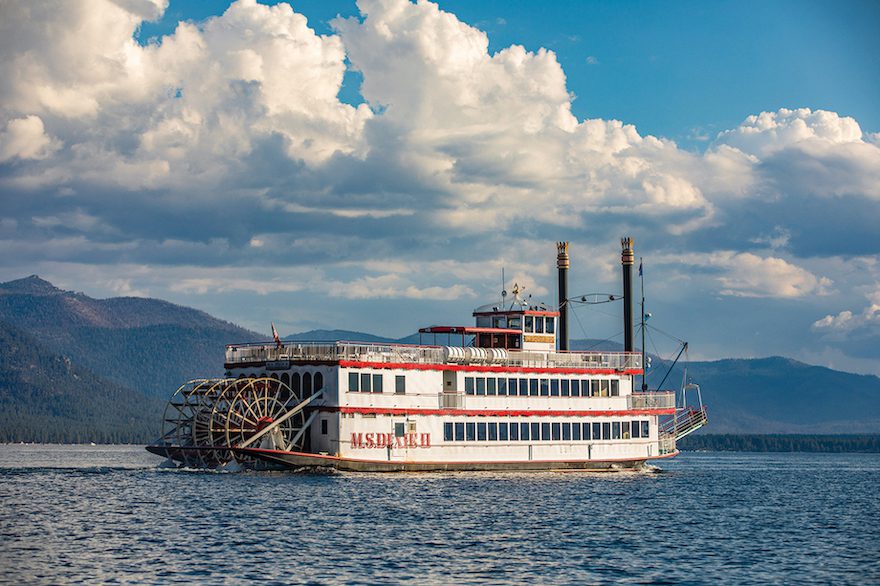
02 May The Best Boats to Skim Big Blue
From luxury to sheer speed, the most memorable crafts to navigate Tahoe are forever etched in the lake’s nautical history
Cruising along Lake Tahoe’s surface provides more than just beautiful views. Via innertube or catamaran, observing the lake and its surrounding peaks from the water has propelled generations of excitement, ambition and vision.
Boating features prominently in Lake Tahoe’s history, and the crafts that have made their names here often mirror the fortune, and sometimes folly, of those inhabiting its shores. Notable vessels at the lake have been dedicated to ample size, speed and style (sometimes all three) and tend to develop a character imbued with their surroundings.
Many are only distant memories, but some of these boats have remained active for decades, making the region’s past something people can enjoy today. Here are a few of the most notable boats that have taken to Lake Tahoe’s waters over the years.
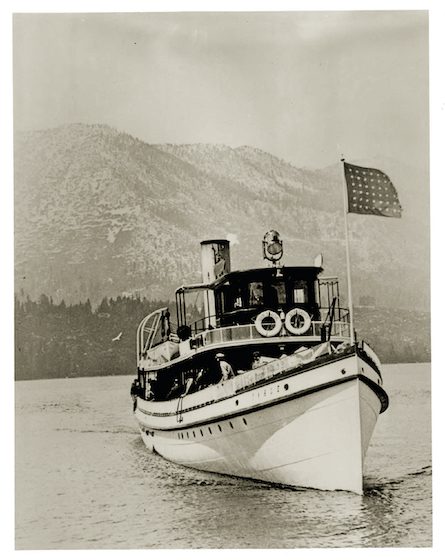
The SS Tahoe steamship was the epitome of luxury, pHOTO COURTESY SPECIAL COLLECTIONS DEPARTMENT, UNIVERSITY OF NEVADA, RENO
Best of the Gilded Age: SS Tahoe
While Tahoe Tessie, the lake’s version of the Loch Ness Monster, remains an unshakeable part of local lore, there truly is something lurking in the depths near Glenbrook—the wreckage of one of Tahoe’s grandest steamships.
Completed in 1896 for Tahoe tycoon Duane Leroy Bliss, the 169-foot SS Tahoe represented the height of luxury on the lake for more than three decades, carrying up to 200 passengers, cargo and mail on daily trips around the lake.
“Two wood-burning boilers turning a 2,400-horsepower turbine that drove two enormous three-bladed props powered the ship,” wrote Matthew Renda in a 2015 Tahoe Quarterly article. “Bedecked with brass and marble fixtures, electricity, steam heat, hot showers and an ample dining room, the vessel was the picture of luxury and style and a symbol of D.L. Bliss’ material success.”
Completion of the highway around the lake in 1930 and the decreasing dependency on water transit ultimately sealed the fate of the steamship, which fell into disrepair in the years leading up to World War II.
Not wanting to see his father’s legacy salvaged for the war effort, Bliss’ son, William, envisioned a sunken SS Tahoe as an underwater attraction where people aboard glass-bottomed boats would get to experience the grandeur of the ship’s remains. Unfortunately for Bliss, the scuttling of the SS Tahoe in 1940 sent the ship into deeper water than anticipated, as it ended up sliding down the steep slope of the lakebed to a final resting place more than 300 feet below the surface—far outside the purview of any glass-bottomed boat.
The SS Tahoe’s specific location was not mapped until more than 60 years later, when a dive team managed to reach the steamship in 2002. Video from a subsequent dive shows the boat largely intact, despite the explosion required to sink it (minor damage was also caused by treasure hunters who found the wreckage in the 1960s and employed a grappling hook and pulley to salvage some pieces).
While not what he intended at the time, the younger Bliss was ultimately successful in preserving the legacy of his father’s ship. In 2002, the SS Tahoe became Nevada’s first submerged site recognized on the National Register of Historic Places.
Best Before its Time: Mercury
A prestigious wooden boat scene is centered on Lake Tahoe’s West Shore, with dozens of classic woodies featured annually at the Lake Tahoe Concours d’Elegance—but one of the show’s notable attractions receives attention specifically because it lacks wood in its construction.
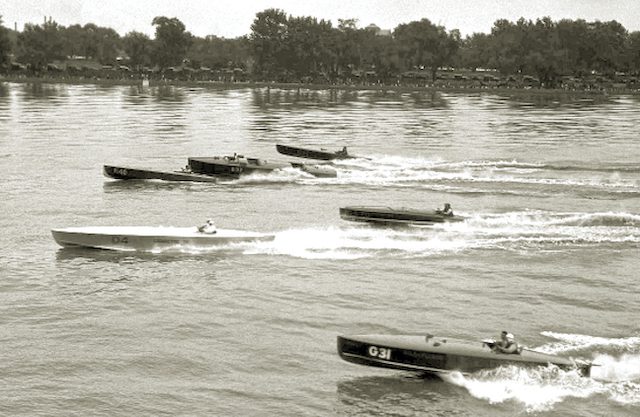
Before its name was changed to Mercury, the newly built Cigarette IV races to victory in the inaugural President’s Cup Race on the Potomac River in 1926, photo courtesy Mystic Seaport Museum
Originally called Cigarette IV when built in 1926, the 35-foot-long craft was the first all-metal speedboat, constructed from an alloy of copper and aluminum known as duralumin.
“More than 4,000 sheets of the metal were used in the hull, fastened by 38,000 rivets and 5,000 bolts,” according to a
New York Times article published on August 18, 1926. “After the boat was taken from the water early last evening following her initial trial the mechanics could not find one rivet or bolt that had given, and there was not a drop of water leakage inside the hull.”
R. Stanley Dollar Jr. purchased the boat in 1937 and had it shipped to Tahoe from the East Coast via Cape Horn, rechristening it as the Mercury.
The aquatic missile of a craft was significantly lighter than its wooden contemporaries and had muscle to spare, boasting a 12-cylinder, 600-horsepower Curtiss aircraft engine at its heart. Mercury had a storied racing career, and photos of the boat in action suggest pure straight-line speed.
According to an article compiled by California State Parks, the boat sustained significant damage from a fuel fire in 1940. Dollar’s mechanic, Dick Clarke, subsequently rebuilt the bottom and engine rails to accommodate a powerful Allison V-12 engine, but the modifications caused Mercury to become unstable when it reached speeds over 65 miles per hour. It was parked in a boathouse, never to race again.
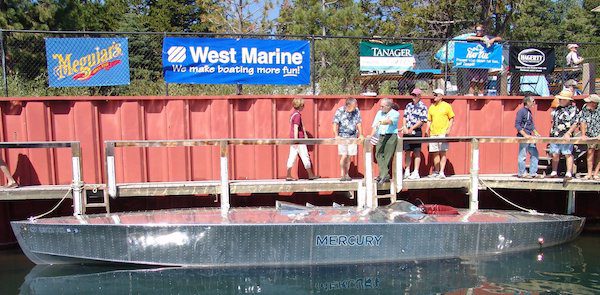
Mercury at the Lake Tahoe Concours d’Elegance, courtesy photo
When Dollar died in 1975, his widow left the boat with the League to Save Lake Tahoe. The League then regifted Mercury to the Sierra State Parks Foundation, which in 1995 transferred the title to California State Parks. In 2002, some 75 years after the vessel’s first victory, Mercury received a new 420-horsepower Mercury Marine V-8 engine.
“Subsequent operation has proved the weight to power ratio of the new configuration to be the best ever,” according to the California State Parks article. “Running on Tahoe at 6,226 feet above sea level, at about 90 percent of throttle, she was recently clocked by a follow boat at 55 miles per hour.”
Natalie Davenport, museum collection manager for the California State Parks Sierra District, had the rare opportunity to captain the living artifact when it was featured at the Concours d’Elegance in 2012.
“I had a grin on my face that I couldn’t wipe off for about two weeks,” Davenport says. “It was the coolest feeling in the world. I’m a skier, and I like to go fast. I like my adrenaline, and driving that boat just fits into the whole Tahoe need for speed—high-speed playing.”
Mercury is currently on display at Ed Z’berg Sugar Pine Point State Park, with Memorial Day through the end of September providing visitors with the most access to the craft. Davenport says she hopes to get Mercury on the lake this summer for maintenance. Future outings are possible, but nothing was scheduled as of March.
“It’s the sexiest boat on the lake. Sorry, Thunderbird,” Davenport says with a laugh.
Best of the Bigs: M.S. Dixie II
While a Mississippi paddle wheeler may seem out of place in the Sierra, anyone who has spent time on Tahoe knows the reliable voyages of the M.S. Dixie II are something that marks the passage of time—both daily and across generations. The 151-foot, 500-plus-passenger boat complete with three decks has ferried sightseeing passengers across Lake Tahoe for decades.
“The memories that it has created, the unique experience that it offers, are quintessential to Lake Tahoe for many people,” says Kevin Schiesz, Tahoe district manager for Aramark Destinations, which operates the paddle wheeler.
Prior to the current iteration, the original M.S. Dixie worked the Mississippi River before it was brought to Tahoe in 1949, with cruises beginning in 1972. The M.S. Dixie II, a similar paddle wheeler with modern amenities, took over the original Dixie’s duties in 1994 and remains the largest boat on the lake.
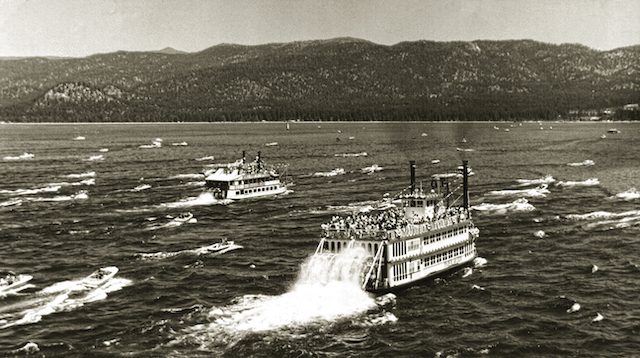
The M.S. Dixie (left) leads the Tahoe Queen in the 1984 Great Lake Tahoe Sternwheeler Race on Lake Tahoe, photo courtesy Thunderbird Lake Tahoe Archives
The M.S. Dixie II has grown to become an enduring icon of Tahoe, not only because of the experience offered aboard and the boat’s distinctive design, but also because of the scale of both the paddle wheeler and the lake.
“Partly, it’s just the size,” Schiesz says of the reasons for the M.S. Dixie II and Lake Tahoe’s decades-long union. “There are not that many freshwater bodies that can accommodate that size boat.”
The M.S. Dixie II hasn’t always been so singular. It once had a counterpart, and occasional rival, in the Tahoe Queen paddle wheeler. The boats squared off for years, sometimes on Labor Day and sometimes Memorial Day, during what was known as the Great Lake Tahoe Sternwheeler Race.
Each traveling about 9 miles per hour, the boats would bring enthusiastic spectators along for a 4-mile race across the lake’s southeast shore, trading the Tahoe Cup (for the winner) and a bedpan (for the loser) back and forth over the years.
The rivalry came to an end in August 2016, however, as the Tahoe Queen caught fire while moored at Zephyr Cove and suffered enough damage that it was scrapped after 33 years traversing Lake Tahoe.
While the Tahoe Queen is gone, the M.S. Dixie II still cruises today and can reach capacity during its busiest season, providing an experience that can be passed down from grandparents to parents to kids.
“Because it’s the second M.S. Dixie, because it has this history and tradition, a lot of Tahoe has grown up around it,” Schiesz says.
Best of the Best: Thunderbird Yacht
Another vessel through which the passage of Tahoe time is written is discretely housed in a “Castle in the Sky” at the northeast corner of the lake. The Thunderbird yacht can be found at the Thunderbird Lodge National Historic Site, the former estate of prominent playboy George Whittell Jr.
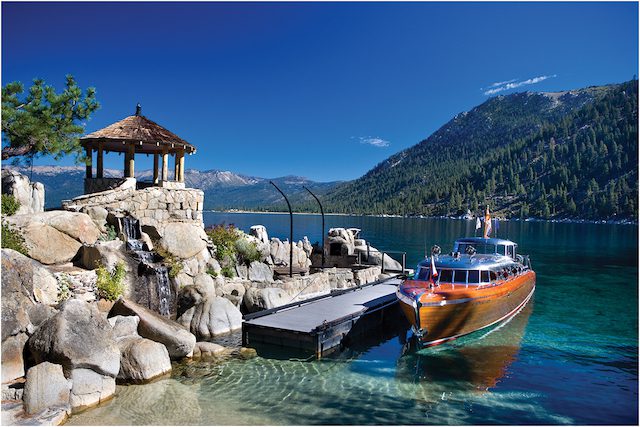
The acclaimed Thunderbird yacht is synonymous with Lake Tahoe, photo by Eric Jarvis
The 55-foot craft is astonishingly sleek, with gently curving stainless steel rooflines bending sky into a polished mahogany hull, which churns through its azure aquatic stage like no other boat in history. The picture of art deco design and natural beauty painted by the combination of the Thunderbird yacht and Lake Tahoe is as stunning today as ever.
Commissioned by Whittell and built in 1939 by famed architect John L. Hacker, founder of Hacker-Craft, the Thunderbird made its way to Tahoe from Michigan via train, its double-planked sides narrowly fitting through tunnels before reaching its destination from Truckee via the Lake Tahoe Railway and Transportation Company’s line.
Underneath the grace of the yacht’s exterior design lies incredible power. When casino magnate William Harrah bought the Thunderbird in 1962, the yacht was retrofitted from its original twin 550-horsepower Kermath marine engines to 12-cylinder Allison aircraft engines from a P-38 Lightning. The engines pushed Thunderbird’s top speed to nearly 70 miles per hour and made it a “floating cocktail lounge” for celebrities like Tony Bennett, Wayne Newton and Frank Sinatra.
“You can feel her coming long before you can see her,” says Bill Watson, chief executive and curator for Thunderbird Lake Tahoe, a nonprofit dedicated to promoting Tahoe’s art, history and environment.
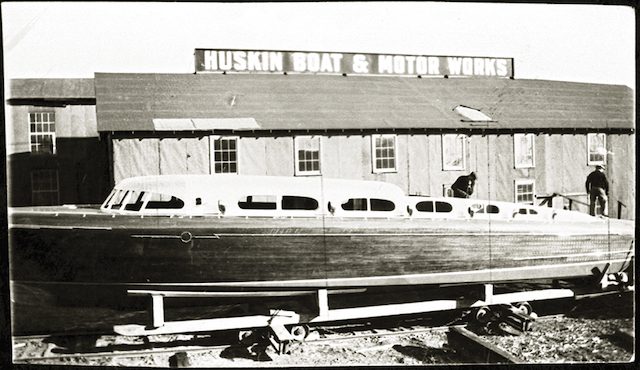
The Thunderbird was built in 1939 at Huskins Boat Works in Bay City, Michigan, photo courtesy Thunderbird Lake Tahoe Archives
Celebrating the yacht’s 85th year, Watson sees the history of Lake Tahoe in the visage of the vessel, describing it as a “window into Tahoe’s maritime past.”
“Lake Tahoe is the intersection of the region’s history, and a lot of that history cruises through the Thunderbird yacht,” Watson says.
The boat cost the equivalent of roughly $2 million when built and was most recently appraised at $6 million. Watson says he has received specific offers of up to $10 million and at least one open-checkbook bid, but he feels the yacht is a priceless piece of Tahoe’s heritage. While the Thunderbird would be an incredible craft anywhere in the world, its significance to the region means it can never find a home as fitting as Lake Tahoe.
“She would still be the Thunderbird, but she would be out of context,” Watson says.
Thunderbird Lake Tahoe offers several ways to experience the yacht, including community exhibitions and volunteer opportunities. A few select private excursions take place aboard the craft each year as part of fundraising efforts. Public tours of Thunderbird Lodge and Thunderbird yacht are available May through October, and the boat often makes an appearance at the Lake Tahoe Concours d’Elegance.
Adam Jensen is a former South Lake Tahoe-based journalist who lives in Modesto.



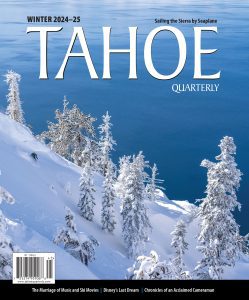
No Comments